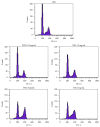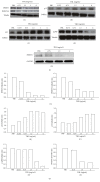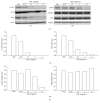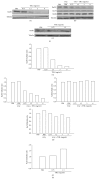Chinese Herbal Mixture, Tien-Hsien Liquid, Induces G2/M Cycle Arrest and Radiosensitivity in MCF-7 Human Breast Cancer Cells through Mechanisms Involving DNMT1 and Rad51 Downregulation
- PMID: 27525019
- PMCID: PMC4971317
- DOI: 10.1155/2016/3251046
Chinese Herbal Mixture, Tien-Hsien Liquid, Induces G2/M Cycle Arrest and Radiosensitivity in MCF-7 Human Breast Cancer Cells through Mechanisms Involving DNMT1 and Rad51 Downregulation
Abstract
The Chinese herbal mixture, Tien-Hsien Liquid (THL), has been proven to suppress the growth and invasiveness of cancer cells and is currently regarded as a complementary medicine for the treatment of cancer. Our previous study using acute promyelocytic leukemia cells uncovered its effect on the downregulation of DNA methyltransferase 1 (DNMT1) which is often overexpressed in cancer cells resulting in the repression of tumor suppressors via hypermethylation. Herein, we explored the effects of THL in MCF-7 breast cancer cells that also demonstrate elevated DNMT1. The results show that THL dose-dependently downregulated DNMT1 accompanied by the induction of tumor suppressors such as p21 and p15. THL arrested cell cycle in G2/M phase and decreased the protein levels of cyclin A, cyclin B1, phospho-pRb, and AKT. DNMT1 inhibition was previously reported to exert a radiosensitizing effect in cancer cells through the repression of DNA repair. We found that THL enhanced radiation-induced clonogenic cell death in MCF-7 cells and decreased the level of DNA double-strand break repair protein, Rad51. Our observations may be the result of DNMT1 downregulation. Due to the fact that DNMT1 inhibition is now a mainstream strategy for anticancer therapy, further clinical trials of THL to confirm its clinical efficacy are warranted.
Figures







Similar articles
-
Targeting PML-RARα and Oncogenic Signaling Pathways by Chinese Herbal Mixture Tien-Hsien Liquid in Acute Promyelocytic Leukemia NB4 Cells.Evid Based Complement Alternat Med. 2011;2011:984154. doi: 10.1093/ecam/nep165. Epub 2011 Feb 20. Evid Based Complement Alternat Med. 2011. PMID: 19897545 Free PMC article.
-
The Chinese Herbal Mixture Tien-Hsien Liquid Augments the Anticancer Immunity in Tumor Cell-Vaccinated Mice.Integr Cancer Ther. 2017 Sep;16(3):319-328. doi: 10.1177/1534735416651492. Epub 2016 Jun 1. Integr Cancer Ther. 2017. PMID: 27252074 Free PMC article.
-
The chinese herbal medicine Tien-Hsien liquid inhibits cell growth and induces apoptosis in a wide variety of human cancer cells.J Altern Complement Med. 2005 Apr;11(2):245-56. doi: 10.1089/acm.2005.11.245. J Altern Complement Med. 2005. PMID: 15865490
-
Elimination of cancer stem-like "side population" cells in hepatoma cell lines by chinese herbal mixture "tien-hsien liquid".Evid Based Complement Alternat Med. 2012;2012:617085. doi: 10.1155/2012/617085. Epub 2012 Oct 14. Evid Based Complement Alternat Med. 2012. PMID: 23097677 Free PMC article.
-
The investigational Aurora kinase A inhibitor alisertib (MLN8237) induces cell cycle G2/M arrest, apoptosis, and autophagy via p38 MAPK and Akt/mTOR signaling pathways in human breast cancer cells.Drug Des Devel Ther. 2015 Mar 16;9:1627-52. doi: 10.2147/DDDT.S75378. eCollection 2015. Drug Des Devel Ther. 2015. PMID: 25834401 Free PMC article.
Cited by
-
Mechanisms of radioresistance and radiosensitization strategies for Triple Negative Breast Cancer.Transl Oncol. 2025 May;55:102351. doi: 10.1016/j.tranon.2025.102351. Epub 2025 Mar 19. Transl Oncol. 2025. PMID: 40112501 Free PMC article. Review.
-
Zhi Zhen Fang formula reverses Hedgehog pathway mediated multidrug resistance in colorectal cancer.Oncol Rep. 2017 Oct;38(4):2087-2095. doi: 10.3892/or.2017.5917. Epub 2017 Aug 23. Oncol Rep. 2017. PMID: 28849164 Free PMC article.
-
Xihuang Pill Induces Apoptosis of Human Glioblastoma U-87 MG Cells via Targeting ROS-Mediated Akt/mTOR/FOXO1 Pathway.Evid Based Complement Alternat Med. 2018 Jun 26;2018:6049498. doi: 10.1155/2018/6049498. eCollection 2018. Evid Based Complement Alternat Med. 2018. PMID: 30046342 Free PMC article.
-
Panduratin A Inhibits Cell Proliferation by Inducing G0/G1 Phase Cell Cycle Arrest and Induces Apoptosis in Breast Cancer Cells.Biomol Ther (Seoul). 2018 May 1;26(3):328-334. doi: 10.4062/biomolther.2017.042. Biomol Ther (Seoul). 2018. PMID: 29301388 Free PMC article.
-
How Should the Worldwide Knowledge of Traditional Cancer Healing Be Integrated with Herbs and Mushrooms into Modern Molecular Pharmacology?Pharmaceuticals (Basel). 2022 Jul 14;15(7):868. doi: 10.3390/ph15070868. Pharmaceuticals (Basel). 2022. PMID: 35890166 Free PMC article. Review.
References
-
- Kuo W.-H., Yao C.-A., Lin C. H., Chang K.-J. Safety and efficacy of Tien-Hsien Liquid Practical in patients with refractory metastatic breast cancer: a randomized, double-blind, placebo-controlled, parallel-group, phase IIa trial. Evidence-Based Complementary and Alternative Medicine. 2012;2012:8. doi: 10.1155/2012/803239.803239 - DOI - PMC - PubMed
-
- Sun A., Chia J.-S., Wang W.-B., Chiang C.-P. Immunomodulating effects of ‘Tien-Hsien liquid’ on peripheral blood mononuclear cells and T-lymphocytes from patients with recurrent aphthous ulcerations. American Journal of Chinese Medicine. 2004;32(2):221–234. doi: 10.1142/s0192415x04001886. - DOI - PubMed
-
- Lai T.-Y., Yao C.-J., Yang C.-M., et al. Targeting PML-RARα and oncogenic signaling pathways by Chinese herbal mixture Tien-Hsien liquid in acute promyelocytic leukemia NB4 cells. Evidence-Based Complementary and Alternative Medicine. 2011;2011:11. doi: 10.1093/ecam/nep165.984154 - DOI - PMC - PubMed
LinkOut - more resources
Full Text Sources
Other Literature Sources
Research Materials

